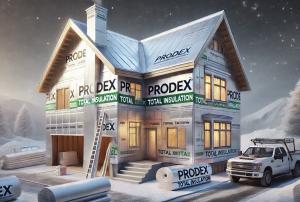Modern House Wrap Insulation: Technical Guide to Moisture Control, Energy Efficiency, and Building Envelope Performance
A Practical, Educational Overview of House Wrap Insulation for Builders, Contractors, and Homeowners
HOUSTON, TX, UNITED STATES, November 12, 2025 /EINPresswire.com/ -- As builders and homeowners push for more resilient, energy-efficient structures, the role of high-performance house wrap insulation has become central to modern wall-assembly design. Recent technical evaluations highlight how integrating radiant, moisture, and thermal control layers into a single system can significantly improve the longevity and comfort of residential and light-commercial buildings.
The Core Challenge: Air Leakage, Moisture Intrusion, and Radiant Heat
Wall assemblies face three persistent forces that degrade performance over time:
Air Infiltration
Uncontrolled air movement reduces heating and cooling efficiency and contributes to uneven indoor temperatures.
Moisture Migration
Water vapor can travel through wall cavities and condense on cool surfaces, leading to mold, rot, or material failure.
Radiant Heat Transfer
Solar radiation and surface temperatures dramatically increase heat gain in warm months and accelerate heat loss in cold months.
Traditional house wraps primarily focus on resisting liquid water—but today’s construction standards demand solutions that also manage air, vapor, and heat movement.
A Three-Part Strategy for Modern Wall Systems
Experts now recommend a multi-layered insulation approach incorporating:
1. Radiant Barrier Layer
Reflects significant radiant heat, stabilizing interior temperatures in both hot and cold climates.
2. Vapor-Permeable Moisture Barrier
Allows controlled vapor escape while preventing liquid water intrusion.
3. Thermal Insulation Layer
Slows conductive heat transfer and contributes meaningful R-value.
This integrated method reduces condensation risk and contributes to a more durable, predictable building envelope.
House Wrap with Perforated Reflective Insulation: An Integrated Solution
One approach gaining increased attention involves a perforated reflective insulation that merges several key functions into a single, lightweight material:
Reflective foil layers capable of reflecting up to 97% of radiant heat
Closed-cell polyethylene foam core for insulation and moisture resistance
Perforation patterns that allow controlled vapor permeability
Structural resilience, resisting collapse, moisture absorption, and mold
Air-resistive and thermal barriers in a unified sheet
The combination of radiant reflection, vapor-permeability, and closed-cell insulation helps maintain stable indoor conditions while reducing long-term moisture-related risks.
Installation Guidance: Field-Proven Best Practices
According to current installation recommendations, the typical process for applying insulated house wrap includes:
1. Stapling to Sheathing
Run the material horizontally from the bottom up.
Fasten using staples spaced 12 to 18 inches apart.
2. Sealing and Taping
Overlap seams and tape joints to maintain continuity of the air and moisture barrier.
3. Optional Furring Strip Installation
Adding 1×3 furring strips every 2–3 feet can create a ventilated air gap that improves drying and enhances insulating performance.
4. Applying Exterior Veneer
Siding, stucco, or other cladding is installed over the insulation or furring grid.
This method reduces thermal bridging and provides a more stable moisture environment inside the wall assembly.
Reported Field Benefits
Users and contractors frequently report:
More stable indoor temperatures during seasonal extremes
Noticeably fewer drafts
Reduced condensation behind wall panels
Improved long-term insulation performance
Resistance to mold, pests, and compression
Faster installation compared to bulky batt insulation
These qualities make insulated house wrap systems especially effective for energy-efficient new construction and retrofit applications.
About This Release
This release is intended to educate builders, inspectors, architects, and homeowners about the mechanics of house wrap insulation and its role in developing resilient building envelopes. It outlines environmental challenges associated with air, moisture, and radiant heat — and describes how modern, integrated insulation systems help address these concerns.
For more detailed installation guides and technical documentation, readers are encouraged to consult:
How to Install House Wrap Insulation
Prodex Total House Wrap Insulation
Metal Building Insulation
Insulation4Less.com Inc. is a leading supplier of innovative insulation materials designed to improve energy efficiency, moisture control, and building performance across residential, commercial, and specialty applications. The company provides technical resources, installation guides, and product solutions trusted by contractors, architects, and DIY builders nationwide.
Jonathan Barber
Insulation4Less.com Inc
+1 281-356-0798
email us here
Visit us on social media:
Facebook
YouTube
X
Prodex Total Insulation Plus
Legal Disclaimer:
EIN Presswire provides this news content "as is" without warranty of any kind. We do not accept any responsibility or liability for the accuracy, content, images, videos, licenses, completeness, legality, or reliability of the information contained in this article. If you have any complaints or copyright issues related to this article, kindly contact the author above.



